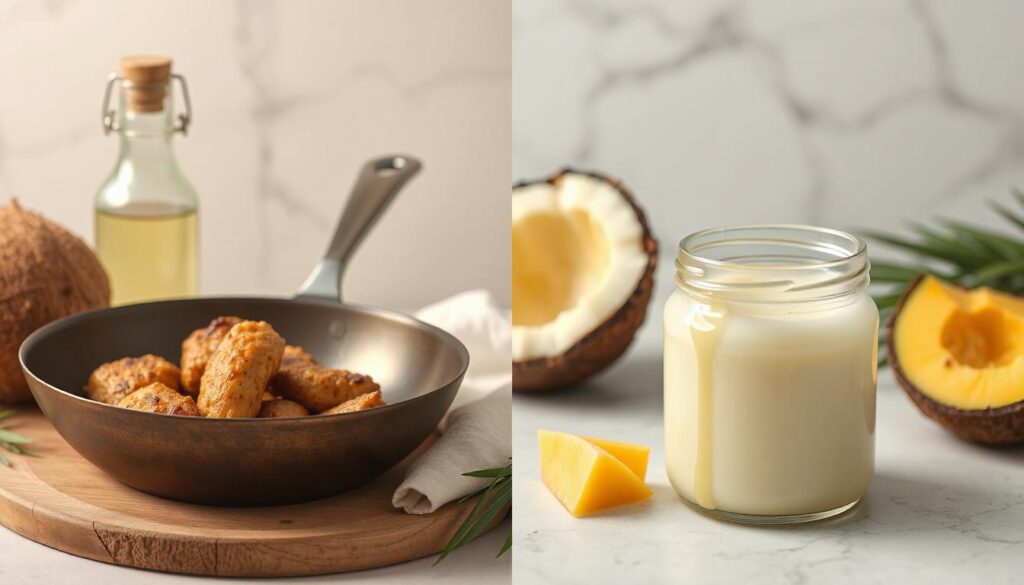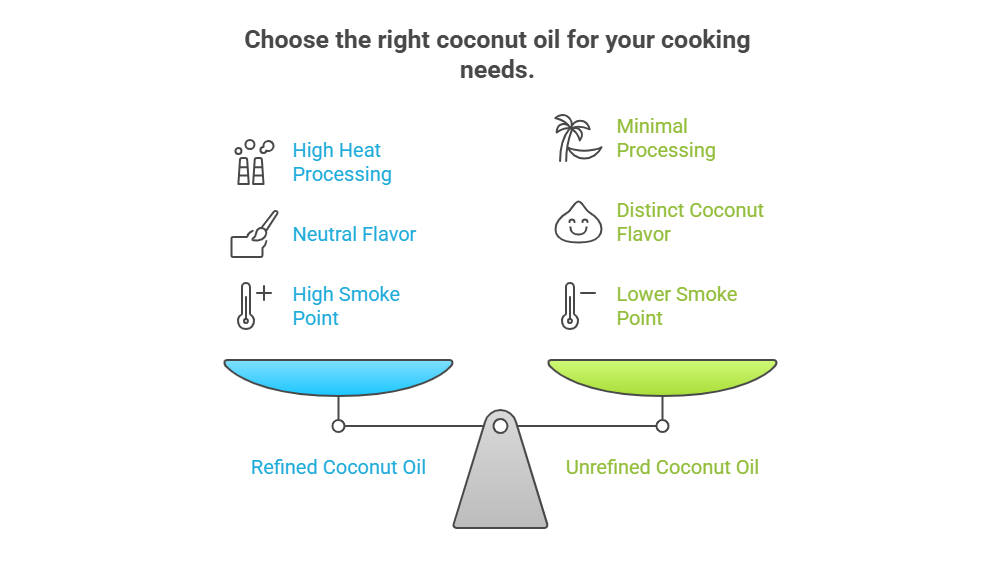With so many coconut oil options on the shelf, how do you know which one to choose? From cooking to skincare, coconut oil has become a household staple, thanks to its impressive versatility and long list of health benefits. But walk into any store and you’re likely to see both refined and unrefined coconut oil—sometimes labeled as “virgin” or “extra virgin.”
That leads to the common question: refined vs unrefined coconut oil — which is better? In this guide, we’ll break down the key differences in processing methods, nutrition, flavor, and best uses so you can choose the right one for your needs.

What is Refined Coconut Oil?
Refined coconut oil is the more processed version of the two. It’s made by extracting oil from dried coconut meat—known as copra—and then refining it to improve texture, taste, and shelf stability.
How It’s Made
The process involves several steps:
- Bleaching & deodorizing: Removes impurities, bacteria, and strong coconut aroma.
- High-heat extraction: Typically expeller-pressed.
- Hydrogenation (sometimes): Some brands partially hydrogenate the oil, which you should avoid due to the presence of unhealthy trans fats.
Characteristics of Refined Coconut Oil
- Neutral smell and taste: Ideal for recipes where coconut flavor isn’t desired.
- Higher smoke point: Around 450°F (232°C)—excellent for frying and sautéing.
- Longer shelf life: More stable and less prone to oxidation.
If you’re looking for a versatile, heat-tolerant oil that doesn’t overpower your dishes, refined coconut oil is a solid choice.
What is Unrefined Coconut Oil?
Unrefined coconut oil, also called virgin or extra virgin coconut oil, is the closest you’ll get to coconut oil in its natural form. It’s minimally processed to preserve its nutrients and natural aroma.
How It’s Made
Unrefined coconut oil is typically extracted using methods like:
- Cold-pressing: Extracts oil without heat or chemicals.
- Centrifuge extraction: Spins fresh coconut milk to separate the oil.
There’s no bleaching, deodorizing, or high-heat treatment, which helps retain its nutritional profile.
⚠️ Note: There’s no official industry standard between “virgin” and “extra virgin” coconut oil—they are generally considered the same.
Characteristics of Unrefined Coconut Oil
- Strong coconut aroma and flavor
- Lower smoke point: Around 350°F (177°C)
- More nutrients: Contains lauric acid, antioxidants, and vitamin E
If you’re after natural nutrition and aroma, unrefined coconut oil is the way to go.
Key Differences Compared: Refined vs Unrefined Coconut Oil
Let’s take a closer look at how the two types stack up side by side:
| Factor | Refined Coconut Oil | Unrefined Coconut Oil |
| Processing | Chemically treated, bleached, deodorized | Cold-pressed or centrifuge-extracted |
| Flavor/Smell | Neutral | Strong coconut taste and aroma |
| Smoke Point | ~450°F | ~350°F |
| Nutrition | Fewer antioxidants | Rich in lauric acid and vitamin E |
| Best Uses | Frying, baking, sensitive skin care | Smoothies, oil pulling, low-heat cooking |
| Price | Usually more affordable | Typically more expensive |
| Shelf Life | Longer | Shorter (but still stable if stored properly) |
Which One is Healthier?

This depends on how you define “healthy.”
Refined Coconut Oil:
- Pros: Better for high-heat cooking, safer for people sensitive to coconut proteins (due to the refining process).
- Cons: Slightly fewer nutrients due to processing. Some versions may contain trace chemicals—check for non-hydrogenated and organic labels.
Unrefined Coconut Oil:
- Pros: Higher levels of antioxidants, antimicrobial lauric acid, and vitamin E.
- Cons: Lower smoke point, which limits its use in high-temperature cooking.
Expert Verdict: For maximum health benefits, unrefined (virgin) coconut oil is generally superior. However, refined still has its place—especially in cooking.
While refined coconut oil undergoes bleaching and deodorization, it’s still a healthier choice than many processed seed oils. For a science-backed ranking of cooking oils, see our guide on the best oils for your diet.
Best Uses for Each Type of Coconut Oil
To get the most out of your coconut oil, use each type strategically:
Best Uses for Refined Coconut Oil
- Deep-frying or stir-frying: High smoke point keeps it stable at high heat.
- Baking: Ideal when you want the benefits without the coconut taste.
- Skincare: Great for people with sensitive skin or allergies to coconut fragrance.
Best Uses for Unrefined Coconut Oil
- Smoothies & raw desserts: Adds a rich coconut flavor and nutrient boost.
- Oil pulling & hair masks: Natural, chemical-free nourishment.
- Low-heat sautéing: Use in light cooking where flavor and nutrients remain intact.
Common Myths Debunked
Myth 1: “Refined coconut oil is unhealthy.”
Reality: While it has fewer nutrients, it’s still a healthy saturated fat source—just avoid partially hydrogenated versions.
Myth 2: “All unrefined coconut oil is raw.”
Reality: Some cold-pressed oils may still be lightly heated. Look for labels like “raw” if that matters to you.
Myth 3: “You can’t cook with unrefined oil.”
Reality: You absolutely can—just stick to low or medium heat.
How to Choose the Right One for You
Choose Refined Coconut Oil if:
- You cook at high temperatures.
- You don’t like the coconut taste.
- You’re on a tight budget.
Choose Unrefined Coconut Oil if:
- You want maximum nutrients.
- You love the natural aroma and flavor.
- You’re using it for natural skincare or raw food recipes.
Storage Tip: Store both types in a cool, dark place. Unrefined coconut oil may solidify in cooler temps—this is completely normal.
Conclusion: Which Do You Prefer?
The difference between refined and unrefined coconut oil comes down to processing, taste, heat tolerance, and nutrition. While refined coconut oil excels in the kitchen, unrefined (virgin) is unbeatable for raw applications and natural wellness.
Which do you prefer—refined or unrefined? Share your favorite uses in the comments below!
If you found this guide helpful, pass it along to a friend and spread the coconut oil love on social media! 🥥✨
